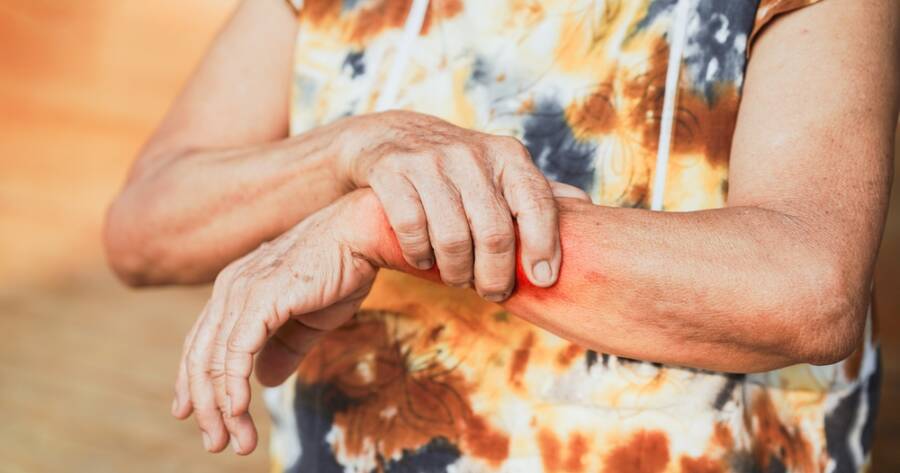Psoriatic arthritis is a chronic inflammatory condition that often affects seniors, causing joint pain, stiffness, and swelling. As it progresses, it can impact mobility and significantly affect daily life. Early detection is essential for managing symptoms and preserving joint function. Be aware of signs like morning stiffness, swollen fingers or toes, and persistent fatigue, as recognizing symptoms early can lead to more effective treatment and improved quality of life.
What Is Psoriatic Arthritis?
Psoriatic arthritis is an inflammatory disease that affects the joints and skin. It usually occurs in people with psoriasis, a skin condition that causes red, scaly patches. However, not everyone with PsA has psoriasis, and it’s also possible for psoriasis to develop after arthritis symptoms appear.
Psoriatic arthritis is an autoimmune disorder, meaning the immune system mistakenly attacks healthy tissues. This can lead to joint pain, swelling, and stiffness, primarily in the hands, feet, knees, and lower back. Left untreated, psoriatic arthritis may lead to joint damage, making it crucial for seniors to spot the early warning signs.
Early Symptoms of Psoriatic Arthritis in Seniors
Joint Pain and Swelling
One of the first signs of psoriatic arthritis is persistent joint pain and swelling. This can affect one or more joints, with common areas including the fingers, toes, and knees. Seniors may notice that their fingers appear swollen, often resembling “sausage fingers” due to inflammation in the surrounding tissues. Joint pain can range from mild to severe, making it difficult to perform daily activities.
Stiffness and Limited Mobility
Joint stiffness is a common symptom, particularly in the morning or after periods of rest. Seniors with psoriatic arthritis may find it challenging to move their joints freely, affecting mobility and flexibility. Morning stiffness may last longer than typical aging-related stiffness, and regular stretching or light movement might not fully relieve it.
Lower Back Pain
Psoriatic arthritis can cause inflammation in the spine, leading to a specific condition called spondylitis. Seniors with this form of PsA may experience chronic lower back pain, stiffness, and discomfort. This symptom can be particularly frustrating, as it often interferes with sleep and daily activities.
Skin and Nail Changes
For those with psoriasis, skin flare-ups may worsen when psoriatic arthritis develops. Common signs include red, scaly patches on the scalp, elbows, and knees. Seniors may also notice changes in their nails, such as pitting, thickening, or even separation from the nail bed. These changes can signal the onset of psoriatic arthritis, especially when accompanied by joint symptoms.
Fatigue and General Malaise
Psoriatic arthritis is an autoimmune condition that can cause fatigue and a general sense of malaise. Seniors with PsA often feel unusually tired, even after a full night’s rest. This fatigue can make it difficult to stay active, impacting mental well-being as well as physical health.
How Is Psoriatic Arthritis Diagnosed?
Diagnosing psoriatic arthritis involves a few steps. Doctors usually begin with a physical exam, checking for joint swelling, pain, and skin symptoms. Imaging tests like X-rays and MRIs can reveal joint damage or inflammation, while blood tests help rule out other types of arthritis, such as rheumatoid arthritis.
A specific marker known as the “rheumatoid factor” is typically absent in people with psoriatic arthritis, which can aid in diagnosis. Additionally, doctors may perform nail biopsies if there are visible nail changes. Early diagnosis is essential, as starting treatment promptly can prevent joint damage and manage symptoms more effectively.
Treatment Options for Psoriatic Arthritis in Seniors
Psoriatic arthritis treatment focuses on managing symptoms and preventing further joint damage. Here are some common options:
Medications: Nonsteroidal anti-inflammatory drugs (NSAIDs) can help relieve pain and reduce inflammation. In more severe cases, disease-modifying antirheumatic drugs (DMARDs) or biologics may be prescribed to slow the progression of PsA. Corticosteroids may also be used for short-term relief.
Physical therapy: Physical therapy can improve joint mobility and reduce stiffness. Exercises tailored to each senior’s condition can help strengthen muscles around affected joints, providing better support and stability.
Lifestyle changes: A healthy lifestyle, including a balanced diet and regular, gentle exercise, can support seniors’ overall well-being. Managing stress, getting enough sleep, and avoiding excessive alcohol can also help control inflammation and improve energy levels.
How Seniors Can Manage Psoriatic Arthritis Daily
Living with psoriatic arthritis can be challenging, but there are ways to manage symptoms and maintain an active lifestyle. Seniors with PsA should consider creating a daily routine that includes gentle stretching and low-impact activities like walking or swimming. Staying active helps reduce stiffness and improve mobility over time.
Pain management techniques, such as applying heat or cold packs to sore joints, can also offer temporary relief. Heat packs can ease stiffness, while cold packs help reduce swelling and numbness. Seniors should consult with healthcare professionals to learn which techniques work best for their specific symptoms.
Finally, support from family, friends, or arthritis support groups can make a positive difference. Talking with others who understand psoriatic arthritis can provide emotional relief and practical advice on managing day-to-day challenges.
Recognizing Psoriatic Arthritis Early Can Help
Psoriatic arthritis can significantly impact seniors’ lives if left untreated, but early recognition of symptoms can lead to effective management. Joint pain, swelling, stiffness, and skin changes are key warning signs to watch for.
With the right treatment plan, including medications, physical therapy, and lifestyle adjustments, seniors can manage their symptoms and maintain an active, fulfilling lifestyle. By staying informed and proactive, seniors can face psoriatic arthritis with greater resilience and confidence.
